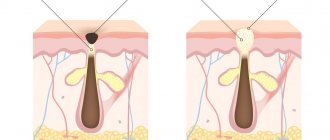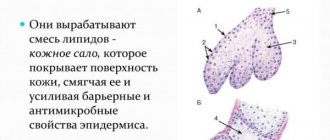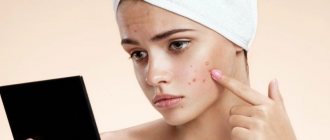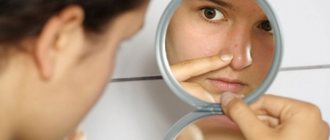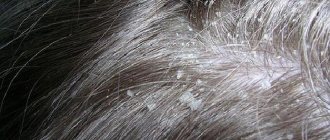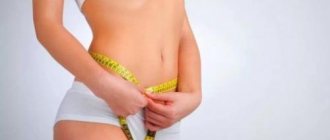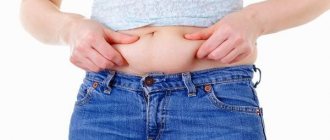06/27/2017 Olga Migunova 3 comments
The face is not only the most exposed part of the body, but also a common location for acne, which can leave post-acne spots - spots, dimples or scars.
The most prone to acne are teenagers who have a lot of complexes about it, because at this age much attention is paid to appearance.
Considering the above, we suggest looking at how to quickly get rid of acne on the face and whether this can be done at home, and, most importantly, without harm to health. We will especially pay attention to how to get rid of acne on the face of a teenager, since this issue is very relevant today. You can also watch a video on this topic.
But first, let’s look at the different types of acne and what causes their appearance.
What types of acne are there?
First of all, it should be noted that a pimple can be either inflammatory or non-inflammatory.
An inflamed pimple is characterized by hyperemia of the skin around the defect, pain, especially on palpation, and the presence of pus.
In turn, among inflammatory acne there are several types, namely:
- papules;
- pustules;
- nodes;
- cysts.
Inflamed pimples
A papule is a small hyperemic tubercle that rises above the skin and turns pale when pressed. Papules pass without a trace and very rarely leave a speck or turn into a pustule.
A pustule is a tubercle with a cavity that is filled with pus and has signs of inflammation. Pustules can form from papules or arise initially.
Untimely and improper elimination of pustules threatens the spread of infection to the deeper layers of the skin or even the penetration of pathogenic microorganisms into the blood. Pustules never go away without a trace, but leave behind spots or scars.
Nodes are painful formations in the deep layers of the skin that can reach large sizes (30 mm). The patient can independently feel the dense infiltrate under the skin of the face.
The color of the skin over the nodes varies from dark red to bluish. This inflamed pimple also never goes away without a trace, leading to the formation of scars and pits.
Cysts are formed from several nodes that are connected to each other by fistulas.
Uninflamed pimples
Non-inflammatory acne is called comedones (blackheads), which are the primary elements of the rash, that is, they precede the formation of inflammatory acne.
Comedon occurs due to blockage of the sebaceous gland ducts with sebum, which mixes with epithelial cells, dust, residues of cosmetics, etc.
It is customary to distinguish between closed and open comedones.
When the comedone is open, the sebaceous plug is on the surface of the skin and is black in color because sebum oxidizes when exposed to air. Due to this, open acne is often called blackheads.
This type of comedones responds well to treatment, but if they are not removed correctly, inflammation may develop and transform into a papule or pustule.
A closed comedon is said to occur when the distal part of the sebaceous gland duct is blocked. This acne looks like a white bump, which is why it is called a white dot.
Unlike an open comedon, the sebaceous plug in this case cannot come out on its own.
Improper removal of a closed comedon very often leads to infection with the further formation of a papule or pustule. We strongly do not recommend dealing with this problem on your own, but seeking help from specialists - a dermatologist or cosmetologist who reliably know how to get rid of acne on the face.
Severity
No less important is the classification of acne by severity, according to which several degrees are distinguished.
- 1st degree : the rash is localized to one area of the face. Mostly the rashes are represented by acne, and sometimes papules and/or pustules.
- 2nd degree : the rash affects two or more areas of the facial skin. Other areas of the body may also be involved in the process. Both comedones and inflammatory elements of the rash appear on the face at the same time.
- 3rd degree : papules and pustules predominate among skin defects. This degree is characterized by pronounced signs of skin inflammation and post-acne (scars, blue, brown or red spots, indentations).
- 4th degree : large papules, pustules, cysts and nodes are formed, which affect several areas of the facial skin and affect its deep layers. In place of acne, the formation of keloid scars is observed.
Age characteristics
Depending on the age at which acne appears, the following types are distinguished:
- children's;
- teenage or youthful;
- adults.
Baby acne (milia) is considered to be those that appear immediately after birth on the skin of the nose, cheeks and chin due to the influence of mother’s hormones on the child’s body.
Milia has no signs of inflammation, does not bother the baby and does not require any medical manipulation, since it goes away on its own within a few weeks after birth.
Juvenile acne refers to those that appear with the onset of puberty at approximately 12-13 years of age.
Hormonal changes begin in the child’s body, which affects the condition of the skin. During this period, the secretion of sebum increases, but the rate of removal of epithelial scales is slow, which creates favorable conditions for the appearance of acne.
Most comedones in adolescents are localized on the skin of the face, but their appearance on the back or chest is also typical.
At the end of puberty, a teenager's skin cleanses itself. But in case of significant rashes, it is necessary to take the child to see a dermatologist, who will give recommendations on how to get rid of teenage acne on the face. In no case is it recommended to self-medicate, as this risks spreading the infection to the deeper layers of the skin and causing gross residual effects.
Adult acne refers to those that appear after puberty. Such defects on the skin are an external reflection of diseases of the internal organs and should not be ignored.
Reason of origin
There are also other types of acne, such as:
- steroid (hormonal);
- exogenous;
- postpartum;
- colds;
- stressful and others.
Steroid acne affects people taking hormonal drugs such as glucocorticosteroids and anabolic steroids. Such defects are especially often observed in bodybuilders who use steroid hormones to gain muscle mass.
Steroid rashes are mainly red pimples on the face, back, shoulders, which look like papules, less often pustules.
The appearance of exogenous acne is caused by various external irritants, for example, low-quality cosmetics, mechanical stress, direct sunlight, etc.
Very often, women in the postpartum period notice acne on the skin of the face, chest and back. Acne after childbirth occurs against the background of a large amount of progesterone in the blood and increased sweating, but its appearance can also be triggered by an incorrect and unhealthy diet, especially the abuse of sweets, soda, fried and fatty foods.
Cold pimples, or pimples, are rashes that occur due to exposure to a draft. Cold pimples differ from other types of pimples by their pronounced hyperemia, and they are also very painful.
Characteristic symptoms
At the beginning of the inflammatory process, red bumps appear, which are very painful when you try to put pressure on them. As they mature, they begin to increase in size. After a certain period, the so-called head of the boil appears, which is white. This is nothing more than accumulated pus, which, after maturation, must come out. But sometimes the abscess is not hidden and the suppurative process is transmitted to the tissues under the skin, leading to their infection. The most dangerous thing is when pimples appear on the head that begin to hurt unbearably. In this case, immediate drug therapy and sometimes surgical intervention are required.
You should immediately pay attention to the appearance of splashes
What causes acne to appear on the face?
can lead to the appearance of acne on the face :
- changes in hormonal levels, which are most clearly demonstrated during puberty;
- hyperkeratosis, which means excessive keratinization of the epithelium;
- increased sebum production;
- unhealthy diet;
- alcohol abuse;
- smoking;
- improper skin care and use of low-quality cosmetics;
- mechanical irritation of the facial skin, for example, from glasses frames;
- occupational hazards (contact with household detergents, technical oils, petroleum products, chlorine and others);
- systemic intake of hormonal drugs (anabolic hormones, glucocorticosteroids) and others.

Now you know what causes acne. It remains to understand how you can get rid of acne on your face at home quickly, effectively and without harm to your health.
How to get rid of acne forever: methods and remedies
There is a huge arsenal of tools and methods with which you can get rid of acne and post-acne. But it should be remembered that squeezing out pimples on your own is strictly prohibited, since such rough manipulation can lead to skin infection, scarring, the appearance of acne spots on the face and the spread of rashes to other parts of the body.
You can get rid of acne only after consulting a dermatologist or cosmetologist, strictly following their recommendations. In addition, treatment will be unsuccessful if the factors that provoke the appearance of rashes are not eliminated.
Drug therapy for acne
Today you can buy inexpensive and highly effective acne treatments at the pharmacy.
Let's look at them.
- Iodine. This antiseptic perfectly dries out rashes, reducing skin redness and other signs of inflammation, and also heals defects. Apply the product with a cotton swab only to the surface of the pimple.
- Spirit of camphor. The drug disinfects the skin, dries the weeping elements of the rash, relieves inflammation and pain. Only targeted use of camphor alcohol for acne on the face is allowed, as it dries out the skin. Apply the product to the pimple with a cotton swab twice a day.
- Vishnevsky ointment. Apply a small amount of ointment to the affected area of the face before going to bed. In the morning, the remnants of the drug are washed off with warm water. Literally overnight, inflammation decreases and pus is drawn out from the deep layers of the skin, thereby accelerating the cleansing of the face.
- Zinc ointment. Zinc, which is present in this preparation, has a pronounced drying effect, destroys pathogenic microorganisms, relieves inflammation and increases the regenerative abilities of the skin.
- Levomekol ointment. This drug contains two active components, such as methyluracil and chloramphenicol. Levomekol effectively destroys pathogenic microbes, accelerates collagen production and relieves inflammation in the area of application. The drug is applied in a thin layer to the facial skin at night.
- Emulsion Zenerit. This drug contains the antibiotic erythromycin and zinc. Zinerite is a highly effective means of combating acne, as it has pharmacological properties such as anti-inflammatory, antimicrobial, drying and healing. The drug also penetrates the sebaceous ducts, resulting in successful removal of acne.
There are also other drugs that will help effectively eliminate acne on the face, such as Dalatsin, Differin, Skinoren, Klinzit S, Baziron, Regetsin and others. But do not forget that any medicine has its side effects and contraindications, so before using them, do not hesitate to consult a specialist.
Face masks against acne
We present to your attention inexpensive and simple recipes for face masks that you can do at home. We recommend performing procedures no more than 3 times a week.
- Recipe No. 1 : rub laundry soap on a fine grater. Pour 30 ml of hot water into a small cup and rub the soap until foam forms, then add 1 teaspoon of fine salt and mix thoroughly. Apply the resulting mixture with your fingers to the acne-affected areas of the face and leave for 20-25 minutes. Wash off the mask with warm water. Reviews from patients indicate the effectiveness of this product. Redness on the skin disappears literally after 2-3 procedures.
- Recipe No. 2 : 100 ml of kefir mixed with 2 tablespoons of chopped oatmeal. Add 1-2 drops of freshly squeezed lemon juice to this mixture. The mask is applied with your fingers or using a special spatula in a thin layer on the skin of the face. The duration of the procedure is from 20 to 30 minutes, after which the product is washed off with warm water.
- Recipe No. 3 : 1 tablespoon of green clay is mixed with 20 ml of olive oil, the white of one egg and kiwi puree. All ingredients are thoroughly ground until a homogeneous mass is formed, and then applied to the skin of the face. Keep the mask on for no longer than 15 minutes.
- Recipe No. 4 : smear the face with liquid honey and leave this mask on for 20 minutes, after which it is thoroughly rinsed with water.
Folk remedies to fight acne
- Oak bark decoction : 30 grams of raw material is poured into 200 ml of boiling water and boiled over low heat for 25 minutes, then left for 30 minutes and filtered through cheesecloth. The facial skin is wiped with gauze soaked in the broth in the morning and evening. This natural medicine has anti-inflammatory, healing antimicrobial effects due to a large number of beneficial substances, among which tannins should be noted.
- Ice : to make ice, use a decoction of chamomile, sage, St. John's wort, oak bark, calendula or other medicinal plant. It is recommended to wipe your face with an ice cube twice a day. This method is suitable for both treatment and prevention of acne.
- Lemon : wipe the area of rashes on the face with a slice of lemon. Lemon juice eliminates excess sebum, dries out pustules and whitens acne spots on the face.
- Toothpaste : Apply a little toothpaste to the pimple at night. Literally overnight the inflammation will decrease.
- Washing with vinegar water : take 15 ml of apple cider vinegar for 4 glasses of water. Wash with this solution twice a day. Vinegar water perfectly removes red spots on the face.
- Aloe : 30 ml of aloe juice is mixed with 15 ml of potato juice and applied to the face twice a day.
How to get rid of acne marks on your face?
It happens that acne spots or scars on the face are much more difficult to eliminate than the breakouts themselves.
Therefore, we will try to answer the question of how you can effectively remove acne marks on your face.
- Red sandalwood paste : 50 grams of sandalwood powder are diluted in 100 warm milk and left to infuse overnight. The paste is applied to the skin where there are red spots after acne as tightly as possible. The mask is washed off after 12 minutes. The procedure is performed 1-2 times a day until acne spots disappear.
- Lemon. Regularly rubbing the skin of the face with a slice of lemon helps lighten spots on the face and reduce the appearance of dimples after acne.
- Ice from a decoction of parsley. Wipe the facial skin twice a day with a piece of ice until the spots go away.
You can also contact a cosmetologist who, using laser resurfacing, vacuum, chemical or ultrasonic facial cleansing, effectively eliminates redness on the facial skin after acne.
Scarring and pitting on the face after acne are successfully treated with drugs such as Contratubes, Klivrin, Badyaga and others. For pronounced scars and deep dimples, a specialist may consider the possibility of surgical correction.
Store-bought acne remedies
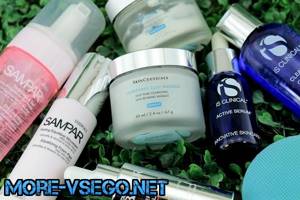
Cream-gel "Clerasil"
The composition is applied to the face twice a week. After spreading, keep it on for 1-2 minutes, then rinse with cool water.
Cream "Floresan"
Apply the cream to problem skin with massaging movements. No need to rinse off. Suitable for daily use.
SOS cream “Propeller”
The cream is distributed pointwise to problem areas. Can be applied several times a day. No need to remove with water.
Garnier “Clean Skin 3-in-1” cleanser
The composition can be used as a scrub, gel or mask:
- mask: spread over damp facial skin, avoiding areas around the lips and eyes, rinse after 5 minutes.
- gel: apply to face, massage for a while and remove.
- scrub: spread over the skin, rub the area of the nose, forehead and chin, remove with cold water.
How to treat certain types of acne?
The choice of acne treatment method directly depends on its type. Therefore, we suggest considering how to properly deal with this or that type of acne.
How to get rid of acne on a teenager's face?
- Refusal to use foundation or powder.
- Daily cleansing of your facial skin using special cosmetics that a cosmetologist will select for you, depending on your skin type.
- Proper and healthy nutrition, which consists of limiting sweets, fatty and fried foods, as well as excluding sweet soda, spices, and alcoholic beverages.
- Vitamin therapy.
- Sports activities.
- Cosmetic procedures from a cosmetologist are recommended for both girls and boys.
- Methods and means of traditional therapy.
How to get rid of hormonal acne?
In this case, it is necessary to find the cause of hormonal imbalance in the body. To do this, you should contact doctors such as a dermatologist, endocrinologist, a woman should definitely see a gynecologist, and a man should definitely see an andrologist. Specialists will conduct a thorough examination of the body and draw a conclusion about what triggered the appearance of steroid acne.
After all, this is the only way to eliminate red pimples on the face, and to speed up recovery, the above-described methods of traditional and traditional medicine can be used.
How to get rid of white pimples on the face?
Such an internal pimple on the face does not cause any discomfort and is removed only for aesthetic reasons.
White subcutaneous pimples on the face should be removed exclusively by specialists - a cosmetologist or dermatologist, who, using a special sterile needle, pierce the comedone and remove its contents. After the procedure, the skin must be treated with an antiseptic, so the pimple does not become inflamed.
How to get rid of cold acne on the face?
A rash from a cold on the face is localized in the deep layers of the skin. Subcutaneous pimples look like painful pimples on the face, and the pain is very strong, especially when you touch them.
We present to you the most effective ways to get rid of subcutaneous acne on the face that has formed due to a cold:
- temporary refusal of foundation and powder;
- ozone therapy;
- darsonvalization;
- high carbohydrate diet;
- drug therapy (ichthyol ointment, Vishnevsky liniment, synthomycin emulsion, Levomekol ointment and others);
- folk remedies that we talked about earlier;
- surgical opening of the abscess.
How to get rid of purulent acne on the face?
Pustules on the skin of the face can be eliminated using methods already known to you, namely ozone therapy, mesotherapy, ultrasonic and mechanical cleansing, chemical peeling, and cryotherapy.
Also, in the fight against purulent acne, you can use iodine, camphor alcohol, Zenerite, various ointments and folk remedies.
How to prevent acne on your face?
Prevention of acne on the face consists of:
- maintaining personal hygiene;
- not squeezing existing pimples;
- regular visits to a cosmetologist;
- proper removal of decorative cosmetics from the skin of the face;
- using high-quality cleansers that match your skin type;
- timely treatment of chronic diseases;
- healthy and balanced diet;
- active lifestyle;
- giving up bad habits.
As a result, we can conclude that the path to getting rid of acne is quite long. In addition, the expected result in the fight against this problem can be achieved only under the guidance of an experienced specialist, and self-medication in most cases is not only useless, but also harmful to health.
Formation and varieties
A pimple begins to form at the moment when, at the site of the follicle, where the ducts of the sebaceous glands go, the scales of the upper layer of skin begin to quickly peel off. Dead cells form a plug that expands the outlet and clogs it.
Bacteria begin to develop in the formations. This promotes the release of toxic substances, resulting in acne. They are different:
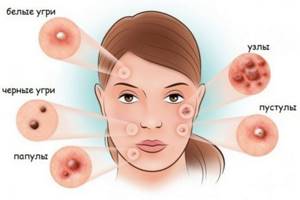
- comedones - if they are open, they are black dots, if closed, then they are compacted white, located under the skin;
- papules - these dense pimples on the face have a red tint and a lumpy appearance. There is no pus and may go away on its own in a few weeks;
- pustules are inflammatory formations with an internal cavity where pus accumulates; they look like tubercles. They are located deep under the skin and gradually come to its surface. In severe form, they can not only affect it, but also fatty tissue;
- cysts tend to become inflamed and pus appears. Over time, they transform into bluish-tinged nodes.
When a red bump appears on your face, you can’t ignore it. Even if there is no pus in it.
Over time, it can begin to cause severe discomfort. Sometimes it is necessary to open the abscess in order to reject the contents. If they are large, then scars may remain at the site of their appearance.
